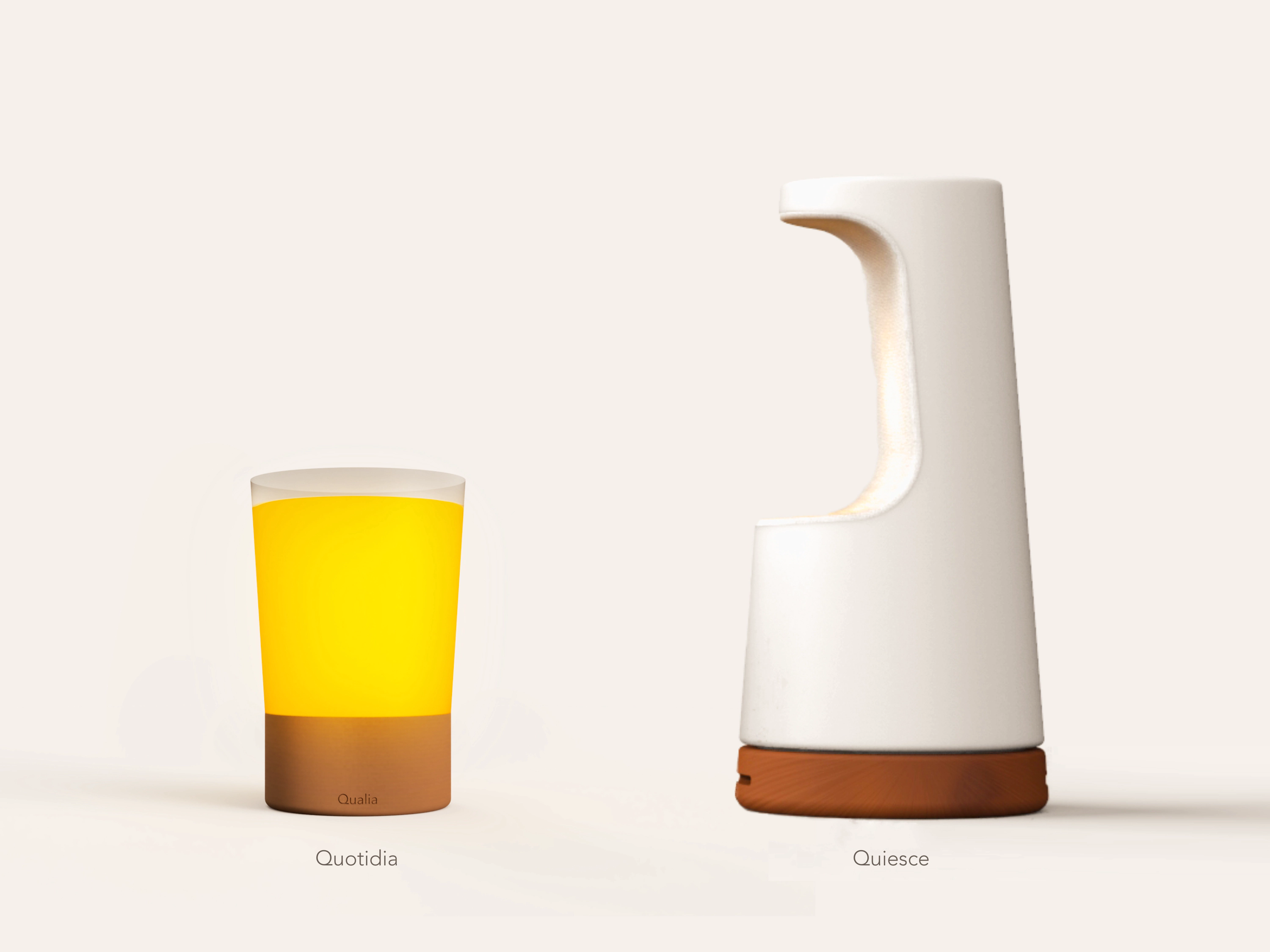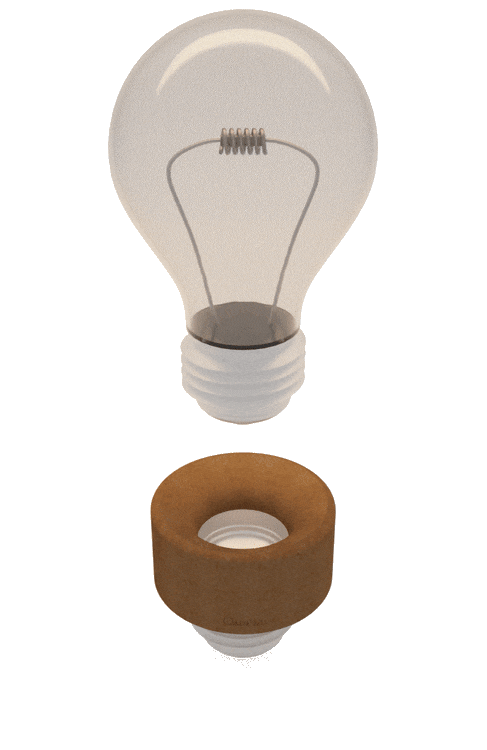
Within the RCA Grand Challenge 2021: Design for Safety, our brief was to design for resilience.
We interpreted safety as wellbeing, and resilience as a system's ability to self-regulate and survive. With this in mind, our research highlighted the worldwide challenge of our ageing population1.
As our populations age, dementia rates are rising. In the UK, it’s estimated that 1/3 of us will care for a person with dementia in our lifetime2, and global dementia rates are expected to triple by 20503. This is accompanied by the fact that fewer working people are available to support the services which older people need.
This presents a huge (and growing) societal challenge: providing sufficient care and support for those affected by dementia.
Cue is a behavioural-guidance system that synchronises with our circadian rhythms.
All of us are at risk of dementia, and Cue aims to increase social resilience by preventing and alleviating some of its challenges. In order to function in both a preventive and restorative way, it embraces an inclusive design ethos: designing in a way that works for diverse needs, aiming for universal (and therefore optimal) functionality4.
Cue's primary target is poor sleep and its complex, bidirectional relationship with dementia. Poor sleep is linked to dementia progression, which in turn disrupts sleep patterns5.
Cue seeks to nurture healthier routines and support the body's natural healing processes by reforming our relationship to artificial light to rebalance our sleep patterns and lives.
By using light to encourage improved sleep and everyday routines, a huge range of positive outcomes spill out from Cue's primary aim: providing a precautionary, preventive and restorative measure against dementia.
We identified three core components of a resilient design:
Ageing populations and increasing dementia rates correspond with reduced social capital and rising care needs.
Our research highlighted a key leverage point: the bidirectional link between poor sleep and dementia progression.
Artificial light disrupts our natural sleep/wake cycles (our circadian rhythm), and light has a particular impact on those living with dementia: leading to disorientation and stress.
The profound effect of poor sleep in society, coupled with the rising trends of both ageing populations and dementia, formed the basic rationale behind the Cue System.
A use-case scenario of a nighttime visit to the bathroom — a time where artifical light typically disrupts our circadian rhythms, and a common cause of confusion for those with dementia.
An accessible, low entry barrier introduction to the system.
A range of devices which retrofit and integrate throughout the home, minimising disruption to users' lives.
We identified three core components of a resilient design:
Ageing populations and increasing dementia rates correspond with reduced social capital and rising care needs.
Our research highlighted a key leverage point: the bidirectional link between poor sleep and dementia progression.

A use-case scenario of a nighttime visit to the bathroom — a time where artifical light typically disrupts our circadian rhythms, and a common cause of confusion for those with dementia.


An accessible, low entry barrier introduction to the system.

A range of devices which retrofit and integrate throughout the home, minimising disruption to users' lives.

We mapped our areas of interest and expertise, using them to triangulate our shared interests and focus the problem space.
This let us explore, outline and define our perspectives, getting to know each other as a team whilst finding direction within this complex challenge: designing for safety and resilience.
Shared sense-making led us to specify this as designing community and ecosystem wellbeing.
We defined resilience as the ability for a system to self-regulate and survive, and outlined three key functional objectives of a 'resilient' design:
This implied that our strategy must be inclusive (and therefore precautionary and able to be preventive) and supportive (helping to reduce the effects of and counteract potential degeneration).
How can we design a precautionary, preventative and regenerative strategy for community and ecosystem well-being?
We began research and ideation around non-clinical approaches to wellbeing to identify potential leverage points.
This approach needed constraining, which we addressed through a rapid stakeholder and empathy map before voting on areas we felt were significant.
This focused us towards an inclusive design strategy for care at home: prioritising those affected by dementia.
How can we apply inclusive design in the home in order to alleviate the risks and challenges of dementia?
How can we apply inclusive design in the home in order to alleviate the risks and challenges of dementia?
Our research revealed a range of risk factors and feedback loops relevant to non-clinical interventions for dementia. 3 key clusters appeared around diet, sleep and exercise.
As we were in the midst of COVID-19, our key stakeholders (those living with dementia and their carers) were vulnerable. As a result, I decided to supplement our desk research with informal discussions with carers. These 3 interviews revealed a wide range of perceived problems and priority areas, as well as highlighting a variety of functional constraints and objectives.
Key insights included that our interventions should be: unobtrusive, retrofittable, progressive and adaptable, customisable, help individual safety, provide clarity about the time of day, attempt to provide an alternative to tranquillisers, be cheap to try out/test, and to be easy to use but not directly adjustable.
These were all incorporated into our eventual design.
Identified issues that weren’t directly addressed in the
final design included preventing over-eating and
basin/bath overflow.
Based on our research, we crafted a range of problem statements, which we synthesised into:
How can we use inclusive design to encourage healthy day/night routines for those living with dementia through the home, and therefore reduce the care burden?
How can we nurture positive routines in the home to support those at risk of or living with dementia and their carers?
We separated into pairs to explore different conceptual directions: Keer and me exploring the potentials of light for therapy and guidance, as highlighted by the desk research, and Francesco and Yurie exploring more divergent possibilities. This was supported by collecting preliminary market research insights as we compared our ideas to pre-existing solutions.
After sketching a number of ideas, shared critique and cross-pollination led to the Cue System: a modular lighting system that responds to individual life activity to guide and nudge us into safer and healthier daily and nighttime routines.
A circadian lighting system for a more resilient society.
Keer Wei and I worked on a generalised journey map for users around the home, particularly thinking about those living with dementia. This let us elaborate, visualise and identify Cue's possible touchpoints, helping us understand its significance in users' daily routine and highlight key interactions.
Forming a basic connectivity and interaction map of these touchpoints let us outline its functions and technical logic, helping to ensure that our design was not only intuitive but also technologically feasible.
By visualising how the system would respond and adapt to
users, we were able to identify key touchpoints with
users and therefore products from which to build the
system; their sensors and controls; how they could
integrate into the home; as well as their functionality
and affordances to the end-user.
Yurie built upon on our preliminary market insights, conducting a more detailed market and competitor audit. This honed our business strategy, pinpointing Cue’s unique position in the market and clarifying our value proposition.
Cue aims to subtly foster healthier daily routines using gentle, warm, light-based nudges. By minimising disruption to lives whilst seamlessly guiding users and introducing healthier habits, Cue aims to increase safety and well-being in the home.
What sets Cue apart is its focus on inclusive design. This means that it's cost-effective, easy to retrofit into existing homes, and modular. It's therefore able to seamlessly integrate with our lives and adjust to evolving user needs. With its focus on being intuitive enough for those living with dementia, the system aims for optimal user-centricity and ease of use. This way, it can not only integrate with all of our lives to reduce the risks of dementia onset, but also support the autonomy and wellbeing of those currently affected by it, and facilitate easier caregiving.
The beauty of this inclusive design strategy is that it encourages a system that is intuitive and useful enough to fit into all of our lives, fostering better individual health and a more resilient society; counteracting the profound individual and social impact of poor sleep and routine.
We decided to keep the designs minimal, clean and functional and therefore minimally-disruptive: fitting with pervasive, standard white light fittings.
Francesco and I created a series of 3D renders to showcase Cue's selection of products: which mesh together to form Cue's smart home ecosystem.
Introductory Collection
These two lamps offer an easy introduction to Cue, with minimal effort to set up.
Qualia Series
Qualia is designed to retrofit and progressively integrate into the home as user needs evolve (designed primarily by Keer Wei and me).
The final stage was to develop a pitch to deliver to representatives from Logitech and the RCA.
To capture its systemic significance, rather than focus on product features, we tried to build a compelling narrative around its rationale and potential individual, social and systemic impact.
My key focus was to develop a series of renders to depict Cue's evolution with user needs through the progression of dementia, progressively integrating into the home as user needs increase.
I wanted to make its real world impact more tangible through a particular narrative and scenarios, as I felt it was important to counteract the perceived distance that the audience might see between dementia's effects and their own lives; making this emerging challenge feel more immediate and relatable.
There’s convicing evidence that Q could effectively reduce the
risks of dementia. Carer feedback has been positive, and it has
a lot of perceived value — far beyond its primary focus on
dementia.
However, in light of the vulnerability of those living with
dementia, its effectiveness for them as an inclusive solution
will need extensive, rigorous testing.
By testing and iterating its design with those living with
dementia it is hoped to not only benefit specific stakeholders
and secure a niche market, but the real beauty of inclusive
design is that it can help us make Cue as intuitive and
adaptable for as diverse a range of lives as possible.
Cue’s practical implications as a system to subtly nudge us into
healthier routines are considerable. It represents a new vision
for our homes: an opportunity for them to become more than a
place of comfort — but also a space that provides active care
and support.
Through improved lighting, sleep and routine, Cue offers a holistic approach to wellbeing with an inclusive design focus: supporting and building social resilience.

This one month project represents a number of my design values, including: inclusivity, better ageing, regeneration and systemic design. I was proud of its potential impact and focus on being cheap, retrofittable and waste-reducing — focussed on delivering real value.
Made during COVID-19 in a global, remote team, it was a challenging project due to the need to work asynchronously and at speed. Our multi-disciplinary team were split across research, product, interaction and communication design: creating a powerful cross-functional approach that helped us collaborate effectively, both together and asynchronously.
Although we didn't have access to studios for physical prototyping and testing, it proved a powerful enough concept to be recommended for funding. Sadly, due to the work commitments and global spread of the team this wasn’t pursued beyond the early stages.
This was a highly collaborative, cross-functional team with a constant sharing of ideas and skills.
Huge thanks to the team for all the brilliant work.